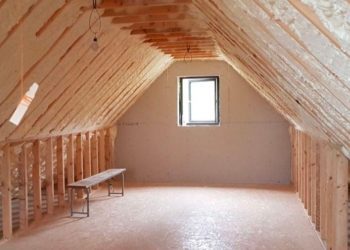Spray foam insulation has become a popular alternative among homeowners trying to increase their property’s energy efficiency. At first, it looked like the best purchase because it was a sophisticated way to keep heat in and save money on energy expenses. However, over time, the potential drawbacks have become increasingly evident. Many property owners around the UK are increasingly discovering that spray foam removal is not simply a matter of preference but a required measure to safeguard health, property value, and the wider environment.
The truth is that spray foam insulation can cause big difficulties that go beyond what it was meant to do, especially if it is put badly or not checked on. The demand for skilled spray foam removal has never been stronger, from environmental contamination to long-term respiratory hazards.
Health Risks Linked to Spray Foam Insulation
One of the main reasons property owners are thinking about not using spray foam is because more people are becoming aware of how it might affect their health. Spray foam insulation comprises a number of compounds, including isocyanates, which are recognised respiratory irritants. These substances can produce asthma-like symptoms, skin irritation, and other allergic reactions. For those with pre-existing respiratory diseases, the presence of these substances in the air might dramatically damage their health.
Spray foam can leave behind residues for years after it has been used. When spray foam begins to disintegrate, minute particles can become airborne and infiltrate indoor air systems. These particles may make the air inside homes less healthy over time, especially in homes that are sealed to save energy. This is one of the main reasons doctors suggest fast spray foam removal, as continued exposure to these compounds can lead to chronic respiratory distress and other long-term health concerns.
There have also been allegations of chemical odours lasting long after installation. Homeowners typically describe these smells as chemical or fish-like, and they can suggest inadequate curing or chemical imbalances. Such difficulties make spray foam removal vital, as continuous exposure to off-gassing compounds can pose unknown health dangers, especially for youngsters, the elderly, and pets.
Risks to property and structures
Spray foam insulation can pose major structural problems in addition to health risks. Once applied, spray foam expands to cover holes and gaps, adhering strongly to surfaces such as timber, brick, or concrete. While this looks useful at first, it might make future upkeep or inspection of the property practically impossible. For instance, moisture or rot under the foam layer can lie unnoticed for years, causing serious damage to the property and expensive repairs.
When moisture gets stuck between layers of insulation, it can speed up the breakdown of building components. timber frames are especially weak because moisture that gets trapped in them can cause mildew to grow and timber to deteriorate. In severe circumstances, this form of hidden deterioration might endanger the building’s structural stability. Spray foam removal is frequently the only option to discover and rectify such underlying damage before it worsens.
In many situations, lenders and surveyors refuse to approve mortgages or property transactions if spray foam insulation is present in loft spaces. This is because it’s hard to judge roof timbers once they are covered with foam. As a result, homeowners wishing to sell often find themselves forced to arrange spray foam removal to comply with surveyor and lender regulations. It can be complicated, but it’s a crucial step to make the house marketable again.
Environmental Consequences of Spray Foam Insulation
The environmental justification for spray foam removal is equally strong. The production and application of spray foam insulation rely primarily on chemicals produced from petrochemical sources. These materials demand tremendous energy to create and release greenhouse gases during both development and installation. Moreover, disposing of spray foam properly creates its own issues, as it cannot be recycled or easily broken down into environmentally beneficial components.
When spray foam insulation begins to disintegrate, it can leak volatile organic compounds (VOCs) into the atmosphere. These pollutants make the air inside and outside dirty, which is bad for both people and the environment. The longevity of these substances in the environment means that the longer foam remains in place, the greater its potential impact. Effective spray foam removal helps lessen long-term pollution hazards and enables the property owner to explore safer, greener insulating alternatives.
Another key environmental problem involves spray foam’s impact on energy performance. While promoted as a high-efficiency insulator, over time, improperly applied or ageing spray foam can develop fractures and detachment points that reduce its insulating capacity. This makes heating systems work harder, which uses more energy and releases more carbon into the air. Homeowners can get rid of bad insulation and replace it with materials that work well without producing any dangerous by-products through prompt spray foam removal.
The Importance of Timely Spray Foam Removal
Because spray foam adheres so strongly to surfaces, removing it can be a technical and labour-intensive process. But the longer it stays, the harder and more expensive it is to get rid of. Delaying spray foam removal generally leads to additional pollution, deeper infiltration into roof structures, and higher material deterioration. Tackling the issue as soon as possible helps prevent these developing complications and can save property owners significant expenditure later.
In addition to structural and health issues, early spray foam removal makes sense from a cost aspect. Mortgage decisions, insurance claims, and resale values can all be influenced by the presence of spray foam. Many insurers are now unwilling to issue coverage on properties containing it due to the problems in checking roofing sections. Prompt removal eliminates this barrier and helps maintain complete transparency in future property transactions.
It’s also crucial to remember that certain older buildings may not fulfil the latest safety regulations. When professionals take something down, they often find that it was installed incorrectly, like using too much or bad materials. Rectifying these issues early through appropriate spray foam removal ensures properties remain aligned with modern safety and environmental objectives.
Looking for safer, more sustainable options
Once spray foam removal has been finished, many homeowners prefer to replace it with more sustainable insulating alternatives. Natural fibres like sheep’s wool, cellulose, or insulation made from hemp are some of these options. They work great for keeping heat in without adding chemicals that could be dangerous. These kinds of goods let air through, can be recycled, and are less prone to keep moisture inside the building.
In picking a replacement, it is crucial to emphasise eco-friendly materials that maintain the home’s energy efficiency while promoting good indoor air quality. Post-removal assessments can aid property owners in identifying the most appropriate remedies for their individual building type. This approach not only removes the hazards connected with spray foam but also adds to longer-lasting building health and environmental sustainability.
So, getting rid of spray foam is a good step towards healthier living spaces and taking care of your home in a responsible way. By eliminating the source of chemical dangers, homeowners create safer homes for their families and nurture higher energy performance utilising modern, sustainable materials.
A Long-Lasting Effect on the Home and the Environment
There are many bad things that can happen if you don’t treat spray foam insulation. The risks are too high to ignore, from breathing problems and bad air quality to hidden structural damage. In many circumstances, properties with spray foam insulation lose value and suffer pushback from both lenders and potential buyers. Taking decisive action through professional spray foam removal gives lasting benefits that extend well beyond immediate comfort.
Removing spray foam not only protects the structure but also adds to a cleaner, healthier atmosphere. It saves future chemical emissions, encourages responsible waste management, and prepares the way for eco-conscious insulating solutions that match with modern sustainability standards. The procedure may be tough, but the results of a safer, healthier, and more efficient house are well worth the effort.
In essence, spray foam removal is not just a maintenance activity but an investment in long-term wellbeing. It restores property integrity, maintains tenant health, and enables for more sustainable insulating solutions that do not sacrifice environmental responsibility. For UK householders aware of the accumulating evidence against spray foam insulation, immediate removal is the wisest and most responsible course of action.









